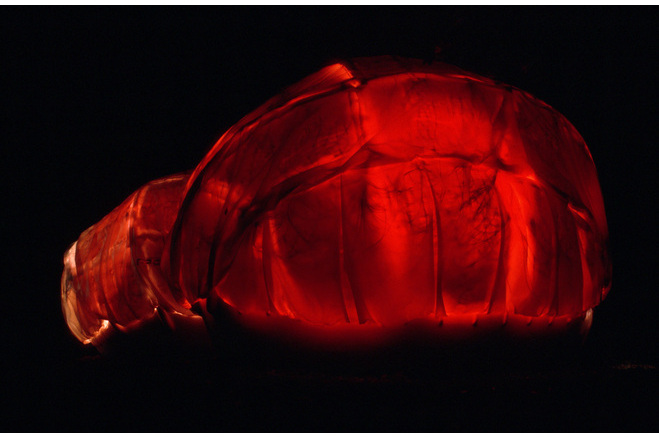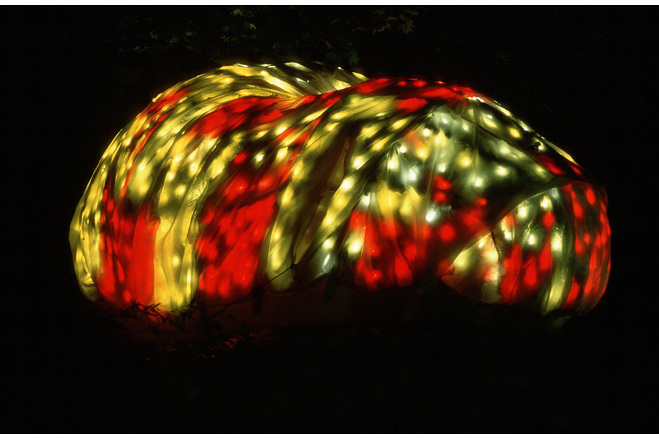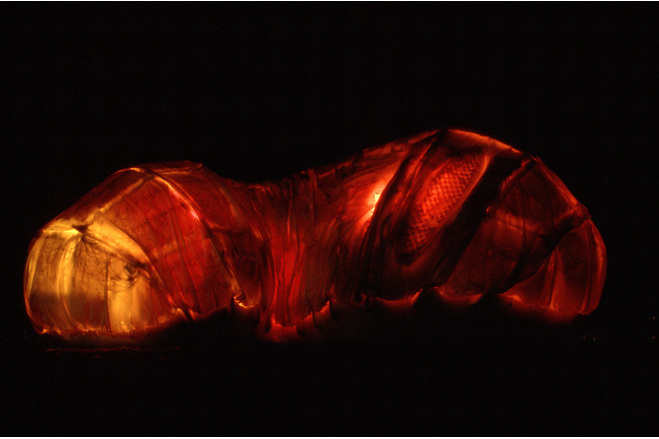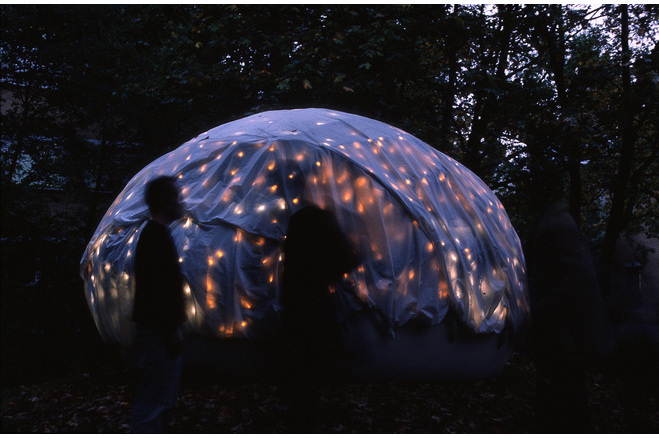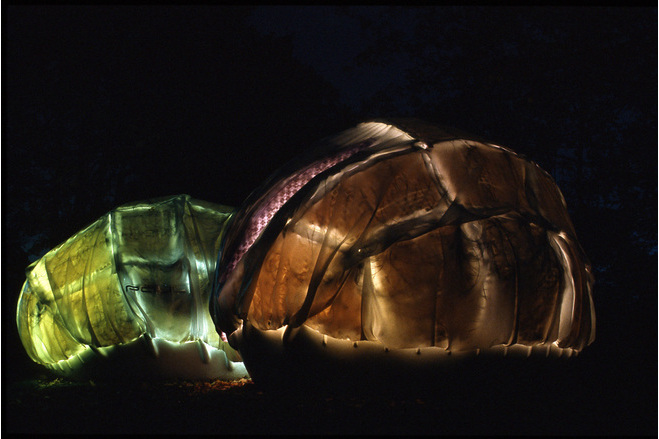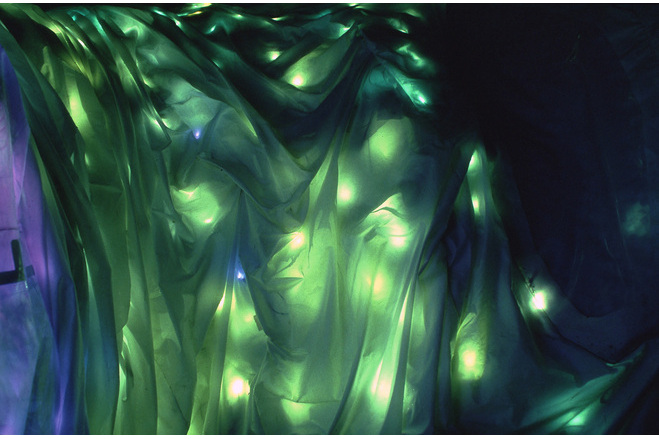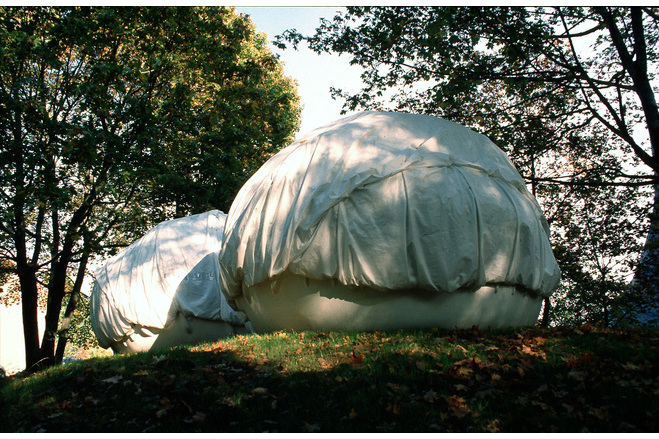Experimental building "PAUL"
General information
-
Location country
Germany
-
Function of building
Shelters
-
Degree of enclosure
Fully enclosed structure
-
Number of layers
mono-layer
-
Type of application of the membrane
covering
-
Primary function of the tensile structure
- Space defining elements
Description
Cocoon "paul" has been developed in the context of a PhD-thesis about “adaptive textile building envelopes”. The work has been carried out at the Institute for Lightweight Structures and Conceptual Design (ILEK) at the University of Stuttgart in co-operation with Professor Werner Sobek. “Paul” is placed next to the former Institute for Lightweight Structures by Frei Otto, which is under the direction of Werner Sobek since 1995.
The study of adaptive building envelopes belongs to the forward-looking developments in the building industry. The goal is to develop aesthetic and physically variable building envelopes. The work covers substantial aspects within the range of architecture and material science. Hereby the first application potentials of the latest technologies and materials in textile membranes are pointed out regarding biomorphic architecture. High-tech and simple, direct accessibility and serviceability were combined. A special role plays the picture, which determined the formfinding procedure as a premise.
"paul" points out analogies from built architecture to living organisms - it is less an organic architecture - rather a built organism - alive architecture. The experimental building represents a symbiosis from "more organic" architecture and High-Tech. The built metamorphosis is able to be reacting automatically to changes of the environment. The possibility for the adjustment to changed environmental condition is obvious in nature and is designated as adaptation. The colour change of the chameleons and the tropism of plants are mentioned on behalf. Architectural constructions and architectures behave so far to a large extent statically, they do not react or only with large energy expenditure to the changes of their environment. The experimental building "paul” has aesthetic and physical not-constant characteristics, and has the ability for automatic adjustment to outside environmental condition. With organic and adaptive structures the proximity to nature becomes visible again. The alleged artefact approaches nature again - on functional and also formal level - and becomes part of it.
Altogether the wall built-up is similar to a living skin - it works, as often used in nature, as a multi-layer-system, which is arranged cellularly. The multi-layer-system is doped with different high functional materials. The top layer of the skin has a very small degree of pre-manufacturing - the skin is not load-carrying - it serves only as weather protection - the folding follows the bimorph entire appearance. The different layers possess individual functions - a multi-layer system from different membranes and function layers. Below the top skin the light layer appears to a form vein or nervous system. This system has an overall length of 8 km and consists of optical glass fibres, which makes a permanent colour change possible using 1200 light spots. The different light conditions are controlled via colour wheels. During the day "paul" appears in monochrome white - at the night the conversion takes place. This variability leads to most different lighting effects - warm and cold tones -- the multicoloured butterfly wing with innumerable coloured light spots or mystic conditions with a vague, non-directional light skin, which dips the whole architecture into a mysterious light: sometimes cheerfully, sometimes darkly and mysteriously - and this in innumerable variants.
Below the light layer one can find the insulation layer - a diaphragm, which is endowed with high-isolating ceramics. Beneath them lies - as internal storage layer - another diaphragm, which is implemented by phase change materials. These can improve sustainable the storage capabilities of lightweight structures by the change of the state of aggregation and the associated reversible absorption and delivery of heat. Insulation and storage layer compose of more than 60,000 cells. At high temperatures the diaphragm is softer than at low temperatures. The acoustic characteristics are improved in relation to conventional fabric structures. The total thickness of the multi-layer-skin is about 1.4cm. Storage and insulation values are comparable to those of a conventional solid wall of approximately 15 cm thickness. The classical architectural elements such as roof and wall are waived - the diaphragm skin is integrative. The lower part of the butterfly group consists of a shape of approximately 8 m length - it is a glass-carbon-fibre-hybrid, that was laid down on the ground – no establishment of a foundation took place. High-grade steel ribs are put into the lower bowl, which are coupled by glass-fibre-rods in transverse direction. The steel ribs describe the generated form of the cocoons and were bent with a program written for it. The largest room height of the accessible cocoons amounts to 3.0 m.
Formally the experimental building reminds of a pupated butterfly, which is located on the site. Although the picture of the cocoons exists, traditional boundaries and formal developments are being questioned - its outlines are vague, which is still superelevated by the variable light arrangement - firm conditions and geometries are being dissolved - boundaries and form smear and are in a permanent state of change. "paul" represents its most characteristic characteristics - its change and adaptability - "paul" is a picture of itself. "paul" reacts to changing external climatic conditions. Beside the built metamorphosis "paul" shows its possible conversion properties by the reversible characteristics of the skin and by the picture of the pupated butterfly group. The pupated group is as metaphor of the change in status and genesis, which happens in the building envelope physically and aesthetically - the non-constant characteristics. By metamorphosis one understands, besides the conversion process, in addition, the existence of variations - in such a way the experimental building exists in this tradition also in "next to each other" different and contrary conditions and attitudes - for instance hard and softly, custom-made and non-confect, smoothly and folded, monochrome and coloured, Low-Tech and High-Tech. This dualism is clarified by the completely contrary day and night conditions. The simple details of the prototype and the treatment of the top weathered layer as "non-confect" represent a strong contrast to the doping of the complex building skin using high-efficient functional materials - from air and space industry, and/or automobile industry. The adding of the membrane among themselves, and/or with the sub-elements, is based on simple mechanism from the clothing technology, it concerns velcro and zippers - they possess models in nature.
Contrary to solid construction types the multi-layer-skin - despite its conditioning properties - is characterised by a high degree of the translucency. On sunny days it is possible to notice the branches and leaves of the adjacent trees blowing in the wind. The building envelope conditions and is nevertheless able to communicate with the environment - one can look through and notice vague outlines. During the night the artificial light of the second layer shines through the insulation and the cell structure appears as a poetic starlit sky. Buildings of the future and possibly all components will be similar to the characteristics of an organism - they possess non-constant properties - building skins with its translucent structure show that future architectures can be airy and light-flooded - skins and cladding structures, which transform architecture into amorphous and diaphane light bodies.
In the context of the work, components and systems are used, which adapt automatically or control the building envelope by chemical and/or physical modifications to changing outside climatic conditions. The possible adaptations serve to optimize the energy and emission balance and to improve the user comfort as well. Technically and aesthetically new possibilities of buildings are shown and fundamental requirements of an "adaptive textile building envelopes" and the possibilities of the shape finding of the overall architecture, resulting from it, are pointed out. Building skins and beyond that architecture, which possess non-constant characteristics, are developed - they are able to change both physically and aesthetically and adapt. The goal is "intelligent" building skins and buildings, which do adapt independently and not computer-controlled or electronically inspired to their environment. With the employment of high-efficient materials - and dealing with light - a sensual architecture can result - an architecture, which lives not only of the mind, but also on moods.
Buildings of the future - and possibly all components - can change and adapt automatically. They behave like an organism - this entails a new style - flexible and alive architectures, which - despite or straight because of the use of high technologies - embody a maximum of sensuality and poetry.
Description of the environmental conditions
Material of the cover
Main dimensions and form
Duration of use
-
Temporary or permanent structure
Temporary
-
Convertible or mobile
Convertible and mobile
Involved companies
Editor
-
Editor
Evi Corne


